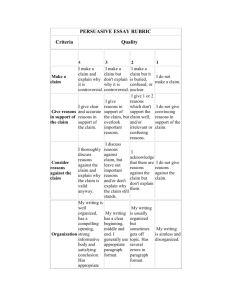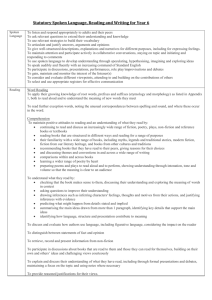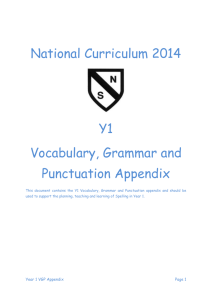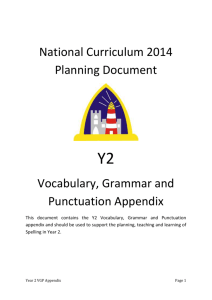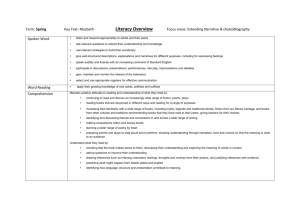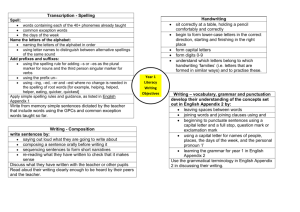Writing performance descriptors years 1-6
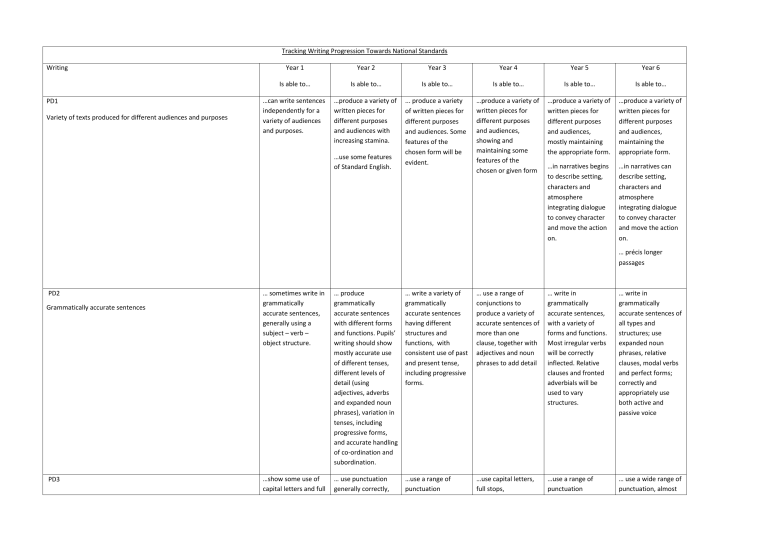
Writing
PD1
Variety of texts produced for different audiences and purposes
PD2
Grammatically accurate sentences
PD3
Tracking Writing Progression Towards National Standards
Year 1
Is able to…
Year 2
Is able to…
Year 3
Is able to…
Year 4
Is able to…
Year 5
Is able to…
Year 6
Is able to…
…can write sentences independently for a variety of audiences and purposes.
…produce a variety of written pieces for different purposes and audiences with increasing stamina.
…use some features of Standard English.
... produce a variety of written pieces for different purposes and audiences. Some features of the chosen form will be evident.
…produce a variety of written pieces for different purposes and audiences, showing and maintaining some features of the chosen or given form
…produce a variety of written pieces for different purposes and audiences, mostly maintaining the appropriate form.
…in narratives begins to describe setting, characters and atmosphere integrating dialogue to convey character and move the action on.
…produce a variety of written pieces for different purposes and audiences, maintaining the appropriate form.
…in narratives can describe setting, characters and atmosphere integrating dialogue to convey character and move the action on.
… précis longer passages
… sometimes write in grammatically accurate sentences, generally using a subject – verb – object structure.
… produce grammatically accurate sentences with different forms and functions. Pupils’ writing should show mostly accurate use of different tenses, different levels of detail (using adjectives, adverbs and expanded noun phrases), variation in tenses, including progressive forms, and accurate handling of co-ordination and subordination.
…show some use of capital letters and full
… use punctuation generally correctly,
… write a variety of grammatically accurate sentences having different structures and functions, with consistent use of past and present tense, including progressive forms.
…use a range of punctuation
… use a range of conjunctions to produce a variety of accurate sentences of more than one clause, together with adjectives and noun phrases to add detail
…use capital letters, full stops,
… write in grammatically accurate sentences, with a variety of forms and functions.
Most irregular verbs will be correctly inflected. Relative clauses and fronted adverbials will be used to vary structures.
…use a range of punctuation
… write in grammatically accurate sentences of all types and structures; use expanded noun phrases, relative clauses, modal verbs and perfect forms; correctly and appropriately use both active and passive voice
… use a wide range of punctuation, almost
Accurate punctuation
PD4
Organise texts
PD5
Vocabulary (both orally and through written work) stops to demarcate sentences; some use of capital letters for names of people, places and days of the week. including full stops, capital letters, question marks and exclamation marks with occasionally accurate use of commas in lists and apostrophes.
… sometimes use a title and/or clearly signal the end of a piece of writing
…show some awareness that writing may be divided into sections
(e.g. through the use of titles, headings or spaces between groups of sentences) accurately, including apostrophes for possession and contraction and commas to separate clauses exclamation marks question marks and apostrophes mostly appropriately. Some use of inverted commas to indicate direct speech. accurately, including commas for different purposes, possessive apostrophes and markers for direct speech. always correctly.
… sometimes divide writing into sections that are helpful to a reader e.g. paragraphs, headings and sub-headings
… organise writing in sections and show awareness of devices that promote successful text organisation e.g. consistently separating themes or ideas through the use of paragraphs, headings and subheadings.
… ensure that paragraphs or sections of writing are linked through the use of cohesive devices.
… demonstrate in writing the use of devices promoting coherence and cohesion e.g. there are links within and between paragraphs and, where appropriate, discourse markers that help readers to locate information or follow a line of argument
…make simple, appropriate word choices to convey meaning.
…use adjectives and some expanded noun phrases for description.
…use and for joining words and clauses.
…use and understand age – appropriate grammar terminology (see
Appendix 2
+glossary) to discuss their writing.
…make some adventurous word choices.
…use adjectives, adverbs and expanded noun phrases to describe and specify.
…choose some words for effect or occasion.
…use adjectives, adverbs and expanded noun phrases to describe and specify with some confidence
…make some adventurous and apt word choices.
…use nouns and noun phrases, modified by adjectives, adverbs and other nouns confidently and consistently to add detail.
…make deliberate vocabulary choices.
…use nouns and noun phrases modified by adjectives, adverbs, other nouns and prepositional phrases to expand and develop ideas, information and description.
…choose vocabulary for effect and amend vocabulary to suit the level of formality
…use expanded noun phrases to convey complicated information concisely
…use modal verbs and adverbs to indicate degrees of possibility, probability and certainty
PD6
Spelling (from Appendix 1)
Grammar (from Appendix 2)
PD7
Handwriting
PD8
Evidence of (re)drafting and proof reading
… has met the majority of the statutory requirements in spelling in appendix
1.
… has met the majority of the statutory requirements in grammar in appendix 2.
… has met the majority of the statutory requirements in spelling in appendix
1.
… has met the majority of the statutory requirements in grammar in appendix 2.
… is working at phase
5 or above (or equivalent)
… is working in phase
6 or above (or equivalent)
… has met the majority of the statutory requirements in spelling in appendix
1.
… has met the majority of the statutory requirements in spelling in appendix
1.
… has met the majority of the statutory requirements in grammar in appendix
2
… has met the majority of the statutory requirements in grammar in appendix
2.
… has met the majority of the statutory requirements in spelling in appendix
1.
… has met the majority of the statutory requirements in grammar in appendix 2.
…write fluently and begin to adopt a personal style.
…hold a pencil comfortably and correctly.
……begin to form and orientate lower case letters accurately.
…form and orientate capital letters and digits 0 to 9
…form and orientate lower case letters accurately, starting and finishing in the correct place.
…maintain some consistency in the size and spacing of digits and letters throughout pieces of writing.
…write in a legible style, showing accuracy and consistent letter formation, sometimes using diagonal and horizontal joins.
…write in a legible style, consistently using diagonal and horizontal joins.
…use spacing appropriately between words.
…plan by saying out loud what the writing will be about.
...discuss their own writing with others.
…with support, reread their own writing to check that what is written makes sense.
…gather and write down ideas and key words.
…evaluate their own word choices, grammar and punctuation through discussion with others.
… has met the majority of the statutory requirements in spelling in appendix 1.
… has met the majority of the statutory requirements in grammar in appendix
…write fluently and legibly at efficient speed.
…adopt and maintain a personal style.
…make choices of style to reflect the purpose of a task.
…gather and write down ideas and key words from a wide range of sources.
...make some clear choices of grammar and vocabulary.
…evaluate their own writing according to purpose, the effectiveness of word choice, grammar and
…evaluate the effectiveness of their own and others’ writing
…suggest improvements to
…make clear choices about vocabulary and sentence structure.
…make clear, appropriate choices of grammar and vocabulary to clarify and enhance meaning.
…evaluate the effectiveness of their own and others’ writing to propose changes to grammar and vocabulary to
…evaluate and edit own and others’ writing to make appropriate changes
…with support, reread their own writing to check for meaning, grammar and spelling errors. punctuation. grammar and vocabulary.
…make simple additions, corrections and revisions, often without prompting.
…proof-read for spelling and punctuation errors. improve consistency. to enhance effects and clarify meaning.
…proof-read for spelling and punctuation errors.
…proof-read to ensure accuracy of spelling and punctuation.
